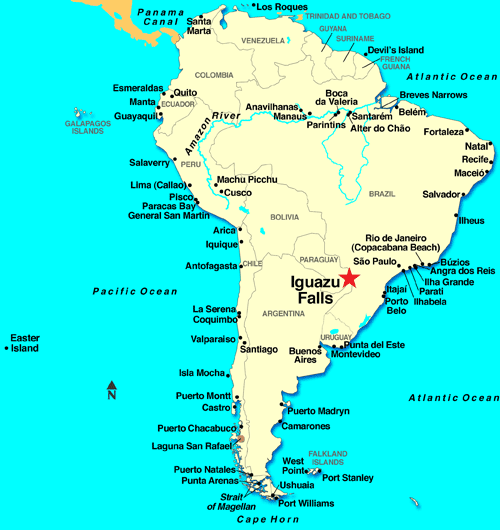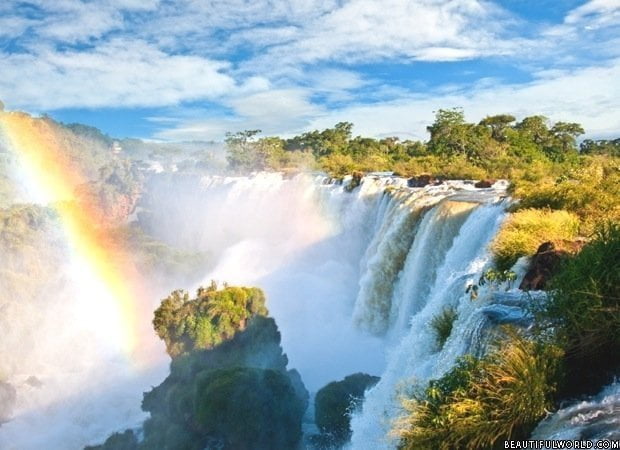Declared a World Heritage site by UNESCO in 1984, Iguazu Falls is often revered as the world’s most spectacular waterfall. Situated on the border of the Brazilian state, Parana, and the Argentine province of Misiones, Iguazu Falls spans 1.7 miles (2.7km) in width, and features 275 individual waterfalls, with heights ranging from 196-270ft (60-82m). The name ‘Iguazu’ is loosely translated from the indigenous Guarani language as “big water”. Unsurprisingly, former first lady, Eleanor Roosevelt, reportedly exclaimed “Poor Niagara” upon seeing Iguazu Falls for the first time. Iguazu Falls is undoubtedly one of the most spectacular treasures of our natural world.

The Iguazu Falls
The falls form part of both the Iguacu National Park (Argentina) and the Iguazu National Park (Brazil), which have both been declared World Heritage sites. Approximately, 80% of the falls are located in Argentina and 20% in Brazil.
Crossing over from one side of the falls to another is not difficult. The footpaths on the Brazilian side tend to focus more on reaching good vantage points to see the panorama, whilst the Argentinean side allows visitors to see the waterfall up-close. It is said that the Brazilian side is for viewing the falls and the Argentinean side is for experiencing them.

Argentinean Side
The Argentinean side of Iguazu Falls offers tourists a number of vantage points to see incredible panoramic views, as well as the opportunity to view the falls from above.
There are two different trails available on the Argentinean side of the falls; the upper falls, and the lower falls. The trail to the upper falls provides the opportunity to walk across several of the falls via catwalk, and to overlook the water flowing over the edges. The lower falls trail, on the other hand, offers some of the best close-up views of the falls. Both trails on the Argentinean side are best taken in the morning hours, when the sun is rising from behind and providing excellent lighting conditions.
Brazilian Side
The Brazilian side offers the most complete panoramic views of Iguazu Falls. Ideally, you should visit in the morning, whilst the sun is behind you, lighting the falls. It is possible to cover the Brazilian side in just a few morning hours.
As such, it is possible to visit both the Argentinean and Brazilian sides of Iguazu Falls, covering all vantage points, in just a day and a half. However, a visit to Iguazu Falls is certainly not an experience to be rushed, and so allowing for more time is recommended.
Devils Throat
The Devil’s Throat (or, Garganta del Diablo) is a U-shaped cliff, marking the border between the two countries. It is often considered to be the most impressive thing about Iguazu Falls. At over 260ft (80m) high, and 1.7mi (2.7km) wide, about half of the Iguazu Rivers water flow spills into the Devil’s throat. With water flowing from 3 sides, it offers visitors a 260-degree view of the waterfall.
It is advised to view Devil’s Throat in the afternoon, as the sun will have risen above the falls by then. If you visit Devils Throat in the morning, the view will be disturbed by the glare of the sun.
Things to do at Iguazu Falls
There is a lot to do at Iguazu Falls, and therefore a 1-day trip is not recommended, particularly when taking into consideration its remote location.
One of the most exciting ways to experience the falls is by taking a jet boat tour. Jet boat tours take you really close to the Falls, so visitors should be prepared to get very wet. You can also get a helicopter ride over Iguazu Falls, to get a spectacular birds eye view. Jungle safari tours offer tourists the opportunity to be educated about the subtropical rainforests of the national park in a fun environment. For adrenaline junkies, rappelling is available at Iguazu Falls. This involves a controlled descent using rope down the vertical cliff face on the Brazilian side of the Falls.
Portrayals in film
The Iguazu Falls have had the honor of featuring in many Hollywood movies, including Mr. Magoo (1997), Miami Vice (1996) and Indiana Jones and the Kingdom of the Crystal Skull (2008).
When is the best time of year to visit Iguazu Falls?
The weather at Iguazu Falls is quite consistent throughout the year, meaning that there isn’t really a bad time to visit, per se. However, there are a few factors that may impact upon your decision.
January and February are the peak visitation periods, as both the Brazilians and Argentineans are on holiday. During the local summer, the water volume is high, and the sky tends to be bluer. However, the heat, humidity and hotel occupation are at their highest. Easter week also sees a vast increase in local tourism.
Some people prefer visiting the Falls during the rainy season (May and July) due to the high water levels and strong flow. However, the months of September and October may provide the best opportunity to experience Iguazu Falls, as the temperature is more moderate, hotel prices are more economical and there are fewer people around.
How to get to Iguazu Falls
The best (quickest & easiest) way to get to Iguazu falls is by air. In Argentina, you will need to catch a flight from Buenos Aires’ domestic airport, El Aeroparque Jorge Newbery, to Puerto Iguazu airport. From the airport, you will then need to drive, or take a taxi/shuttle to your accommodation. In Brazil, you will need to fly into Foz do Iguassu airport, from Sao Paulo, Rio de Janeiro, or another major Brazilian city. If you are travelling to Iguazu Falls from Paraguay, you can drive to the falls via the Friendship Bridge.














We visited Iguazu Falls last year. This is incredible attraction. Located in Brazil and Argentina.
Highly recommended for all of you.
So beautiful
YES .It deserves to be one of the seven natural
Wonders on our earth.
We visited for 3days 16 to 18th of October.
And spent 2days on the Argentinian side, and 1 day
on the Brazilian side.
Although the river was running at about 45%
of it’s normal higher level it was spectacular
And a fantastic experience..
YES .It deserves to be one of the seven natural
Wonders on our earth.
We visited for 3days 16 to 18th of October.
And spent 2days on the Argentinian side, and 1 day
on the Brazilian side.
Although the river was running at about 45%
of it’s normal higher level it was spectacular
And a fantastic experience..